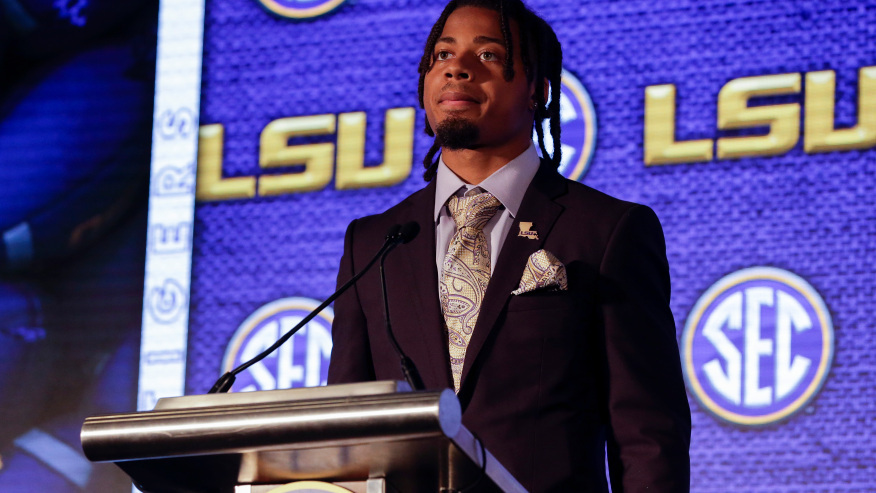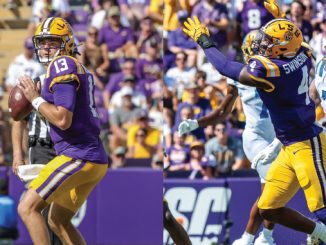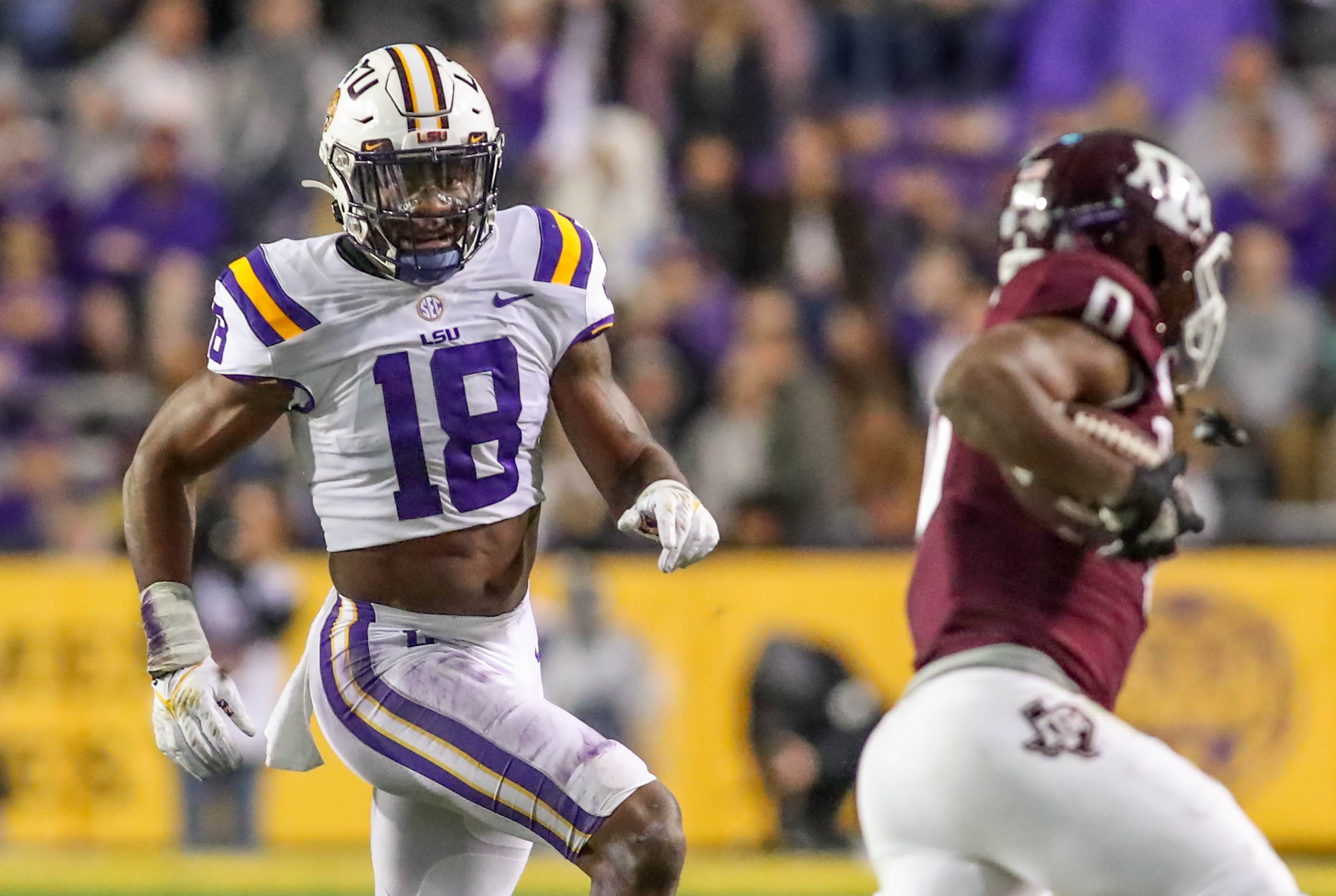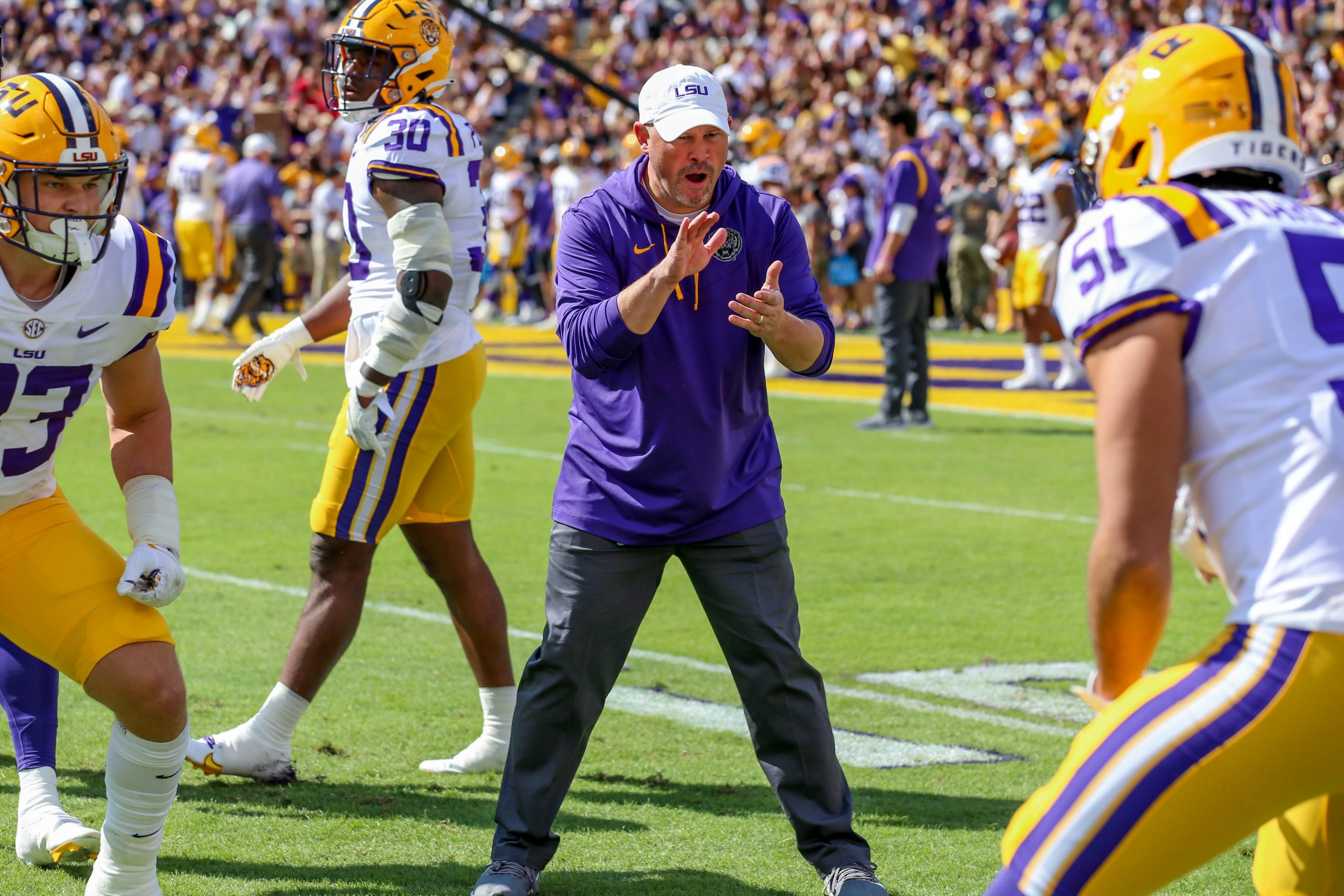
That Derek Stingley Jr. was this year’s choice to wear the coveted No. 7 jersey during LSU’s 2021 season wasn’t necessarily a revelation.
In fact, it was almost preordained since the former Louisiana Gatorade Player of the Year arrived from The Dunham School in Baton Rouge three years ago, helping the hometown Tigers to a 15-0 record and national championship in his first season.
He’s grown to become the program’s most recognizable face where he’s carried the legacy of his family’s name with an athletic elegance and grace on the field mixed with a tremendous sense of humility off of it.
“I’m very excited,” Stingley said July 19 during SEC Media Days, relishing his opportunity to share in the bond of wearing No. 7 for Tigers like his idol former LSU All-American Patrick Peterson. “It’s always been something I’ve seen as a kid and the hype around it and what everybody did with the number. That’s what I look forward to doing. I really want to leave a mark.”
Stingley’s third season at LSU is expected to his list. The 6-foot-1, 195-pounder and two-time, first team All-American is a consensus Top 5 pick in next spring’s NFL Draft where he would follow in the talented footsteps of his late grandfather Darryl Stingley, a wide receiver, who was a first-round selection of the New England Patriots 48 years ago.
The younger Stingley, whose father Derek Sr. began his college career playing cornerback at Purdue before switching to baseball at Triton (Ill.) College and eventually being drafted in 1993 by the Philadelphia Phillies, also finds himself on the periphery of talk about this year’s Heisman Trophy. The Heisman’s only been won once by a defensive player, Michigan’s Charles Woodson in a 1997 upset over Tennessee quarterback Peyton Manning.
Stingley could also become LSU’s first three-time All-American voted to the first team in 50 years, joining exclusive company that only includes former great Tommy Casanova (1969-71). He’s also been named to the preseason watch list of the Chuck Bednarik Award, Jim Thorpe Award and Bronko Nagurski Trophy.
“Yeah, it’s cool to hear that stuff, but I like to focus on the team and what we can do as a group,” Stingley said. “This year I’m looking forward to the season and the things we have to do. I’m not focused on what’s after the season.”
Stingley could certainly enhance his chances at being in the conversation for the Heisman but like Woodson proved more than two decades ago, for a defensive back to win college football’s most iconic individual award more than just defending wide receivers is expected.
Woodson also enhanced his chances at winning the ultimate prize by returning punts and that’s something for the past two years Stingley has done with a career return average of 12.9 yards with a long of 48 yards and no touchdowns in 23 attempts.
There’s also been a building discussion, something LSU head football coach Ed Orgeron first broached during Stingley’s recruiting process, that by the time he was a junior, Stingley may see some time on offense at wide receiver which was another position he thrived in during his high school career.
Stingley has remained noncommittal on becoming a two-way player and instead choosing to focus more on refining his craft on defense after LSU underwent a change at defensive coordinator with Daronte Jones.
“That just depends on what Coach O wants and if he needs someone to do that, then we’ll talk about it,” Stingley said.
Orgeron has remained open to having one of his most talented players on the field on both sides of the ball. But he stopped short of a total endorsement of the notion, taking into account the potential additional risk of injury that would take Stingley away from his natural position and leave the Tigers vulnerable before confirming during fall camp he was preparing a menu of offensive plays for Stingley until he got hurt.
Admittedly, the addition of playing another position that’s already well stocked, is not the most pressing thing in Stingley’s mind heading into the 2021 season. Given the nature of his career where wins have been plentiful followed by an array of plaudits, the was nothing to adequately prepare him for last year’s COVID-shortened season that proved taxing mentally for a 20-year-old who spent the first game of the season in a hospital bed after being rushed to the hospital the night before the Mississippi State game because of an unspecifed illness.
He would later suffer a concussion and injuries to an ankle and quadriceps muscle that cost him three games, including the final two, in a season in which LSU closed the season with two wins to salvage a breakeven 5-5 record.
He recorded 27 tackles, had 2.5 tackles for loss and broke up five passes but was unable to secure an interception after picking off six passes as a freshman.
Stingley was voted to the All-SEC’s first team and first team All-America teams for a second straight season.
“My main focus is staying positive through everything,” Stingley said. “There were times where things weren’t going right, and it was hard to deal with. I talked to a lot of people and read a lot of things on mental health. That’s what I’ve been working on. I didn’t really feel 100 percent at any part of the season.”
NFL scouts will be paying particularly close attention. They’ve already fallen in love with Stingley’s size and length which enable him to thrive in tight man-to-man coverage. His exceptional athleticism and footwork allow him to run step for step with explosive wide receivers, showing off a tremendous change of direction and the innate ability to jump routes and make explosive plays on the ball.
It’s been template from a childhood that’s led up to this point. At the age of four, his father brought to the football field and had him start learning how to backpedal. His dad wanted him to try and make an unnatural motion eventually become second nature.
By the time Stingley Jr. was 7, he was talking defensive coverages and techniques with his father, who after three years in the Philadelphia Phillies’ organization, returned to the Arena League Football. First, he was a player where he accumulated 19 career interceptions and 110 pass deflections, before moving into a role as a coach, whereas an 11-year-old Stingley Jr. competed in practice against other defensive backs during individual drills.
“For him, it’s just like walking or drinking water or breathing,” Stingley Sr. said of his son to Bleacher Report. “It comes natural because it’s all he’s ever done. I never forced him to do anything. He just always wanted to do it.”
Stingley’s career path appeared to be in perpetual motion. As a 14-year-old in Baton Rouge, he started as an eighth-grader always on Dunham’s varsity football team.
A year later, then LSU head football coach Les Miles extended a scholarship offer to Stingley who went on to intercept 14 passes over his final 20 games. He was regarded among the nation’s No. 1 overall prospect by Rivals.com and a five-star prospect that was always fascinated with LSU’s defensive backs such as Peterson, Tyrann Mathieu, LaRon Landry and Jamal Adams.
Stingley’s early commitment to Miles appeared tenuous after the coach was dismissed four games into the 2016 season. But Orgeron who took over as the Tigers interim coach, was able to regain Stingley’s commitment and secured his signature in December and welcomed him on campus shortly thereafter as a mid-term graduate.
With the Tigers beginning their preparations for the Fiesta Bowl, Stingley practiced with the team and had an interception against the first team offense in less than two hours.
“I came here to get better,” said LSU wide receiver Ja’Marr Chase, who went on to win the Biletnikoff Award in 2019 and became a first-round draft choice of the Cincinnati Bengals. “Going up against defensive backs like him (Stingley).”
Stingley wasn’t permitted to play in the actual bowl game but rejoined his teammates for spring training several months later where they began putting the pieces in place for what turned into the greatest season in school history.
Led by Heisman Trophy-winning quarterback Joe Burrow, LSU’s offense was a juggernaut that mauled opponents and overshadowed a developing defense that rounded into shape during the team’s stretch run.
Opposing quarterbacks discovered quickly that Stingley was capable of locking down his side of the field and in the midst of LSU’s dream season in the making, was the emergence of one of the nation’s top defensive backs.
Four games into his career Stingley came up with his first interception at Vanderbilt – the first of three straight – when he delivered his first signature moment in a tense home game with Florida – a 42-28 victory that wasn’t secured until Stingley’s fourth-quarter heroics with an interception of quarterback Kyle Trask in the end zone.
By the time LSU’s team hit the postseason Stingley, who wound up with 38 tackles, was just warming up and matched a SEC Championship game record with two interceptions in a 37-10 victory over Georgia to send the Tigers to the CFP semifinals against Oklahoma.
That brought Stingley arguably his toughest matchup to date against Oklahoma’s leading receiver CeeDee Lamb, who wound up a first-round draft pick of the Dallas Cowboys. Lamb couldn’t stop talking about his encounter with LSU’s freshman cornerback who later helped the Tigers secondary contain Clemson standout quarterback and eventual No. 1 overall NFL draft choice Trevor Lawrence in the championship game, holding him without a passing touchdown for the first time all season and second time in his career.
“I’ve seen the field, and I’m just like, wow, there’s no way he’s a freshman,” Lamb said afterward. “He’s definitely going to be by far the best defensive back I go against.”
Stingley, who had a SEC-best 21 pass deflections, became a unanimous selection on the All-SEC first team, was voted the All-SEC Newcomer of the Year and was voted to first team All-American by eight different news organizations.
“I think he’s one of the top five cornerbacks in the country,” Burrow said after the season. “He would get drafted in the first round this year as a true freshman.”
For Stingley, the success was also a validation that he could successfully carry the family’s athletic torch and flourish in a pressured-packed world because of the name on the back of his jersey.
There was also an extraordinary low associated with that family’s football DNA that Stingley was too young at the time to comprehend but has done his best to represent in a positive fashion.
Darryl Stingley was on considered to be on his way to becoming the highest paid wide receiver as a member of the New England Patriots in the NFL when he was paralyzed in a 1978 exhibition game. He took a vicious hit from Jack Tatum of the Oakland Raiders that broke two of his vertebrae that left him paralyzed from the neck down at the age of 26.
Darryl Stingley died nearly 30 years later at the age of 55 from complications as of a result of being a quadriplegic.
Stingley Jr. was only 5 at the time at the time of Darryl’s death, but it became evident throughout his formative years and into high school, he had developed the ball skills of his grandfather and the defensive skill of his father – a combination that’s pushed him to become one of college football’s best players who’s certainly destined for an even bigger stage ahead.
“I talked to a couple of the previous (No.) 7s like Tyrann Mathieu,” Stingley said. “I asked him how to be the perfect leader and there is no perfect way. I’m a quiet guy. He told me that I didn’t always have to go out there and scream and yell and be a rah-rah guy. I started noticing that whenever I had something to say, people listened. I didn’t think I was all that. I just thought I was a normal guy.”




A healthy Stingley makes LSU a much better football team.
However, one must ask oneself if the opting out debuted a
year ago will persist. Championships can only be won
with full participation.
I should have added that this is a business decision for the players.
We are in the midst of a new epoch. The players have more power now, and they are
exploiting the changes. College football programs like LSU are NFL
factories–de facto minor leagues, for the National Football League.